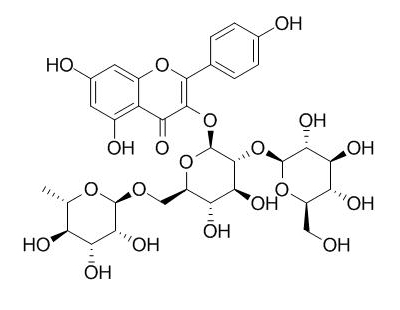Camelliaside A
Camelliaside A is a natural product from Camellia oleifera Abel.
Inquire / Order:
manager@chemfaces.com
Technical Inquiries:
service@chemfaces.com
Tel:
+86-27-84237783
Fax:
+86-27-84254680
Address:
1 Building, No. 83, CheCheng Rd., Wuhan Economic and Technological Development Zone, Wuhan, Hubei 430056, PRC
Providing storage is as stated on the product vial and the vial is kept tightly sealed, the product can be stored for up to
24 months(2-8C).
Wherever possible, you should prepare and use solutions on the same day. However, if you need to make up stock solutions in advance, we recommend that you store the solution as aliquots in tightly sealed vials at -20C. Generally, these will be useable for up to two weeks. Before use, and prior to opening the vial we recommend that you allow your product to equilibrate to room temperature for at least 1 hour.
Need more advice on solubility, usage and handling? Please email to: service@chemfaces.com
The packaging of the product may have turned upside down during transportation, resulting in the natural compounds adhering to the neck or cap of the vial. take the vial out of its packaging and gently shake to let the compounds fall to the bottom of the vial. for liquid products, centrifuge at 200-500 RPM to gather the liquid at the bottom of the vial. try to avoid loss or contamination during handling.
Journal of Molecular Liquids2022, 364:120062.
J Biochem Mol Toxicol.2021, 35(5):e22731.
Plants (Basel).2024, 13(6):868.
Food Sci Nutr.2023, 00:1-10.
J Cell Physiol.2020, 10.1002
Food Chemistry: X2023, 101032.
Antioxidants.2022, 11(3):592.
Toxicol Mech Methods.2021, 1-12.
Ind. J. Pharm. Edu. Res.2023; 57(3):1132-1139.
Immunopharmacol Immunotoxicol.2024, 46(4):496-508.
Related and Featured Products
J Sci Food Agric. 2011 Oct;91(13):2315-21.
Isolation and anti-inflammatory effect of astragalin synthesized by enzymatic hydrolysis of tea seed extract.[Pubmed:
21567414 ]
The application of tea seed extract (TSE) has been widely investigated because of its biological activities. In this paper, two flavonol triglycosides in TSE-Camelliaside A (CamA) and camelliaside B (CamB)-were subjected to hydrolysis in the presence of two commercial enzyme complexes (Pectinex™ series): Smash and Mash.
METHODS AND RESULTS:
Smash hydrolyzed only the xylosyl moiety of CamB, and the main product was kaempferol diglycoside (nicotiflorin, NF). On the other hand, Mash induced the hydrolysis of both CamA and CamB, and kaempferol monoglycoside (astragalin, AS) was found to be a main product. Pure AS with > 96% purity was prepared by enzymatic hydrolysis of TSE using Mash, and the chemical structure of AS was confirmed by (1)H- and (13)C-nuclear magnetic resonance analyses. The prepared pure AS showed anti-inflammatory activities by significantly inhibiting cellular nitrite oxide (IC(50) = 363 µg mL(-1)), prostaglandin E(2) (IC(50) = 134 µg mL(-1)) and interleukin-6 production (IC(50) = 289 µg mL(-1)) by lipopolysaccharide -stimulated RAW 264.7 cells.
CONCLUSIONS:
It was concluded that pure AS can be prepared by enzymatic partial hydrolysis of TSE and employed as an anti-inflammatory material. This is the first study to address the preparation of pure AS from natural sources.
J Sci Food Agric. 2013 Jan;93(2):362-7.
Novel synthesis of leucoside by enzymatic hydrolysis of tea seed extract.[Pubmed:
22777867 ]
The application of tea seed extract (TSE) has been widely investigated owing to its biological activities. In this paper, two flavonol triglycosides found in TSE, Camelliaside A (CamA) and camelliaside B (CamB), were subjected to hydrolysis in the presence of three commercial enzyme complexes of the Pectinex® series, 5XL, XXL and Ultra SP-L (Ultra).
METHODS AND RESULTS:
XXL and 5XL induced stepwise deglycosylation of CamA and CamB to yield kaempferol diglycoside (nicotiflorin), kaempferol monoglycoside (astragalin) and kaempferol, while Ultra produced an additional new compound (1) that had not been observed in earlier studies. Upon hydrolysis of isolated CamA and CamB, compound (1) was obtained only from CamB. Both the molecular ion peak in liquid chromatography/mass spectrometry and the 1H and 13C nuclear magnetic resonance spectra of (1) isolated by Ultra-induced hydrolysis of TSE indicated that (1) was kaempferol 3-O-β-xylopyranosyl (1 → 2)-β-glucopyranoside (leucoside), formed by selective hydrolysis of the rhamnosyl moiety of CamB.
CONCLUSIONS:
Pure leucoside can be prepared by enzymatic partial hydrolysis of TSE. This is the first study to address the synthesis of pure leucoside from a natural source.



